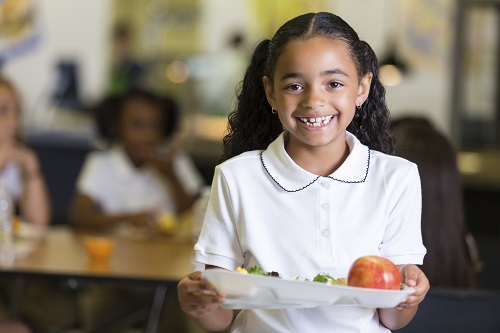As parents, we’re are always concerned about our children’s diet and development. There are so many do’s and don’ts—and scary statistics—that sometimes it’s not clear if we’re on the right track.
What is important is that we provide balance at home and school because what your child eats—or doesn’t eat—can affect their mood and academic success.
One in four adolescents are plagued with hunger, while one in five are obese. Both conditions have serious consequences—children who experience hunger are more likely to be late or absent from school, have difficulty concentrating and develop behavioral problems such as anxiety, aggression, mood swings and hyperactivity.
Children who are overweight or obese are more likely to experience sadness, loneliness and anxiousness, and perform worse on academic tests than children with lower BMIs.
What does this have to do with school meals?
Schools work towards addressing child hunger and obesity through school meal programs. The Healthy, Hunger-Free Kids Act passed in 2010 requires that school breakfast and lunch follow updated nutrition standards. These include serving more whole grains, fruits, vegetables and lean meats, while limiting sodium, trans fat and saturated fat.
School lunches before and after the Healthy, Hunger-Free Kids Act
Before: One serving of fruits or vegetablesAfter: One serving of vegetables and one serving of fruits
Before: No guidance on types of vegetables served
After: Must serve a variety of vegetables, beans and peas, while limiting starchy vegetables such as potatoes
Before: Whole grains are encouraged
After: At least half of the grains served must be whole-grain rich
Before: One cup of any type of milk
After: One cup of milk that is either fat-free and can be flavored or low-fat and unflavored
Before: No limit on trans-fat in school meals
After: Zero grams of trans-fat allowed in school meals
While school meals continue to improve, many schools still face an array of problems that impact if students eat these two meals available every day.
Meals that don’t look or taste good, students not having enough time to eat, food service staff not having the knowledge or equipment to meet the updated meals standards, loose district-level school meal policies and cafeterias that do not promote healthy choices can influence whether or not a student chooses to eat a school meal.
As a parent, how can I help improve school meals?
Just like other components of school health and children’s success, it’s important for parents to be involved to create and mobilize solutions. Now the hard part, where do you start? Simply having a conversation with your school principal and food service manager is your first step to improving school meals.
This conversation will give your food service manager and principal an opportunity to explain the updates they have made, the struggles they are facing and what your role can be.
Here are some ideas to get you thinking!
Improve the cafeteria
- Offer fruits and vegetables in a fun and appealing way—“Power peas” or “dinosaur broccoli trees” sound better than plain old peas or broccoli.
- Display white milk before chocolate milk in the milk cooler. Students are more likely to grab the easy-to-reach option.
- Ensure water is available to all students. Try fruit- and vegetable-infused water for added nutrients—Citrus cucumber-infused water, anyone?
Advocate for improved school wellness policies
- Advocate for recess before lunch. Studies show kids eat more vegetables and are less anxious when having recess before lunch.
- Find out if your school has adopted the Smart Snacks Standards. If not, work with your PTA and school officials to establish stronger policies for foods and beverages sold in school.
Spruce up the menu
- Hold a student recipe contest and highlight the winner on the lunch menu. This will also give students a sense of ownership over the school meals.
- Identify unpopular menu items and work with your food service team on new and tasty recipes. Enlist your PTA superstar cook or community chef for help.
- Fundraise for a school salad bar! Salad bars are a great opportunity for students to self-select fruits and vegetables and try foods they haven’t had before.
Get the word out
- Help your food service team explain the school meal nutrition standards, highlight changes to the menu and promote the lunch and school breakfast program.
- Have lunch with your kid so you can better understand what your kids are eating, taste it yourself, and engage in the school meals conversation.





